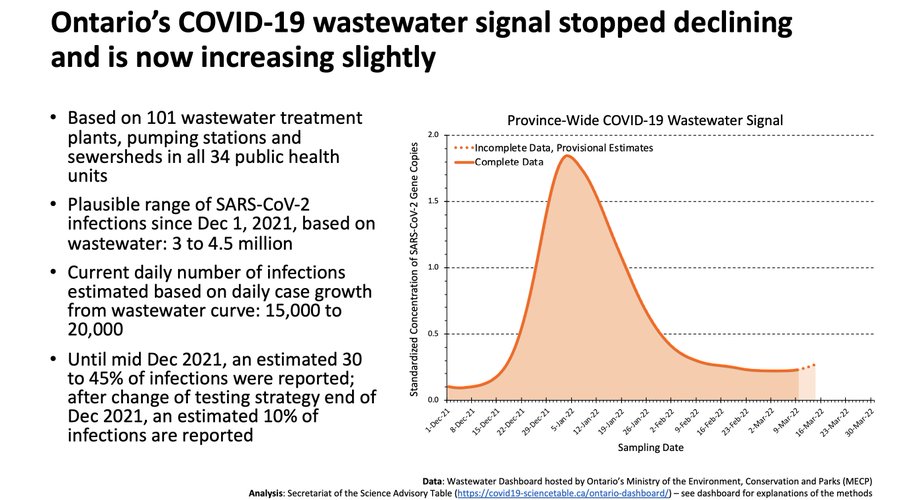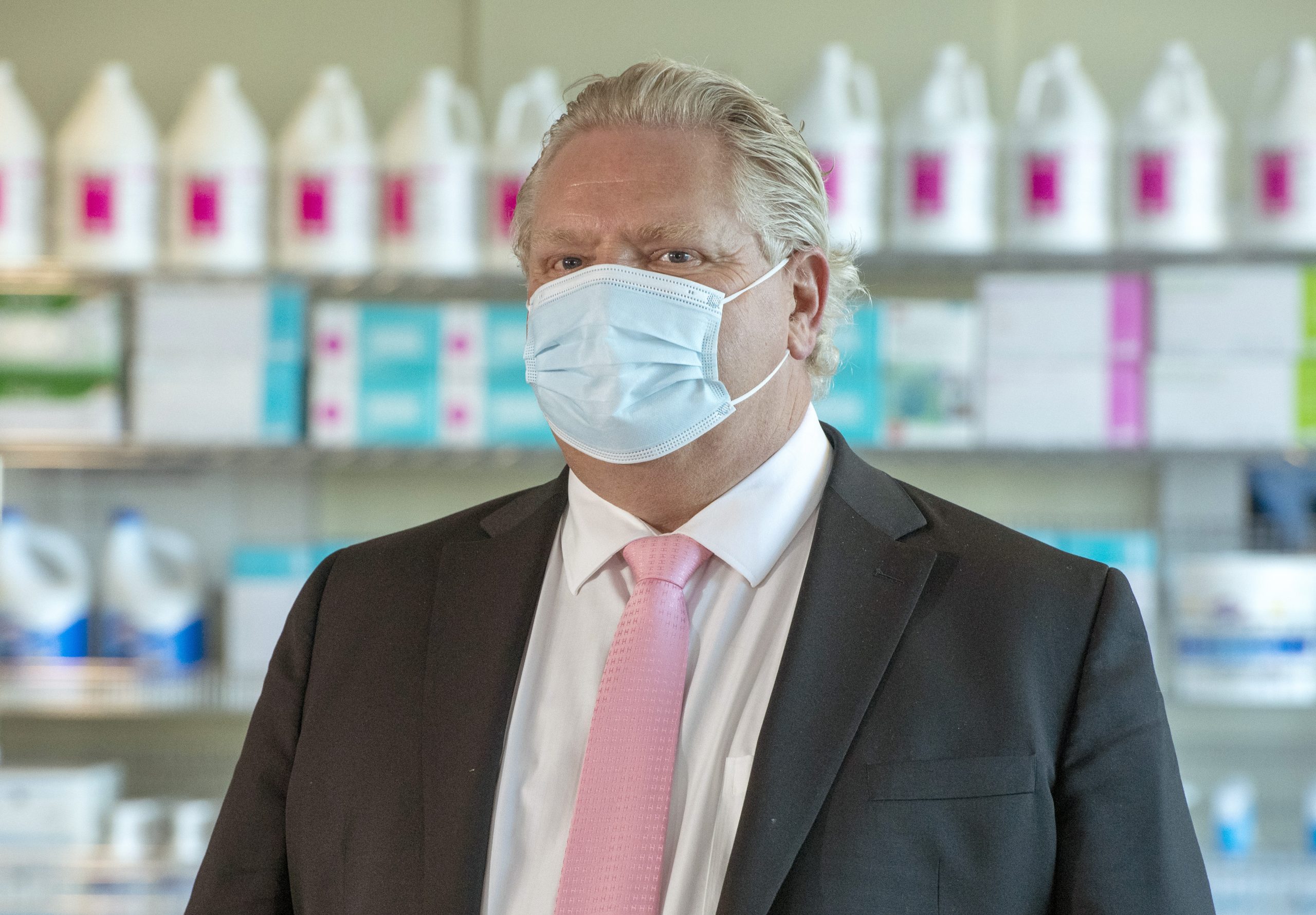COVID-19 could storm back as result of relaxed health measures: Ontario Science Table
Posted March 17, 2022 7:31 am.
Last Updated March 17, 2022 5:28 pm.
Ontario’s Science Advisory Table released updated COVID-19 modelling on Thursday, concluding that the province will likely see a bump in hospitalizations and ICU occupancy as public health measures cease, noting that the increase won’t be as significant as seen in January.
Among the key findings, the science table says daily COVID-19 cases, hospitalizations, and ICU occupancy is no longer declining. They noted that the presumed increase depends on close contacts, particularly for those unmasked and indoors.
The science table says that the spread of subvariant BA.2 and individual vaccination status will also play a factor.
Next Monday, masks will no longer be required in schools, grocery stores, malls, or other indoor areas. Masking requirements will remain for public transit, long-term care, retirement homes and healthcare settings, congregate care settings, shelters, jails and homes for individuals with developmental disabilities.
All remaining mask rules will be lifted on April 27, and remaining emergency orders and directives will be removed or expire.
“Nonetheless, we’re likely to see less of an increase in hospitalizations than in January,” members of the science table said. “We can keep it low by getting vaccinated, wearing good masks when inside, and increasing contacts only moderately.”
The science table reveals that the wastewater signal is no longer dropping in terms of daily cases and that Ontario is “probably seeing 15,000 to 20,000 new infections every day.” Test positivity has also halted, and in some populations is growing a bit.
Poor and low-income neighbourhoods provincewide are still the hardest hit by the pandemic and COVID-19 transmission, as they have been since the beginning.
A spokesperson for the minister of health, Christine Elliott, defended Ontario’s handling of the pandemic to date.
“Ontario has done significantly better than the best-case scenario provided in the last modelling. We now have the lowest rate of hospitalizations out of all provinces,” Alexandra Hilkene said on Thursday.
“We have continued to maintain the capacity to provide care for all patients who need it, and our hospitals can manage any range in these latest projections.”

Ontario’s latest round of COVID-19 modelling examples on Thursday, March 17, 2022. Photo courtesy: Ontario Science Advisory Table.
Other key findings:
- Third doses (as well as first and second shots) are as critical as they have ever been. But they’ve plateaued and are especially low among poorer Ontarians.
- Immunity is Ontario’s best protection against a future COVID-19 variant. The science table says masks are still vital in reducing spread.
- The global pandemic isn’t over, and Ontario remains vulnerable. New variants are likely to emerge if many immune-compromised individuals aren’t treated or don’t get vaccinated.
The updated projections were the first from the panel in over six weeks and the first since the province lifted most public health measures at the beginning of the month.
The consistent downward trend of hospitalizations in recent weeks has started to level off, and many experts have expressed concern with surges of the Omicron subvariant BA.2 reported in other countries.
Related:
-
Omicron staying on surfaces, remaining infectious longer than other variants: Study
-
Health Minister says Ontario’ keeping a close eye’ on global surge of stealth Omicron
Elliott says BA.2 will eventually make up 50 per cent of cases in Ontario — but so far, it has not led to rising hospitalizations in the province. The new sub-variant dubbed “stealth Omicron” is driving up COVID cases in China and the U.S.
As a result, the science table urges residents to continue wearing high-quality masks in specific settings and stay home when sick or symptomatic. They’re also recommending a return to mask mandates if needed.
The science advisory table notes that while 56 per cent of the global population has received at least two COVID-19 vaccine doses, it isn’t enough to build sufficient immunization against current and future variants.
China is now facing its biggest outbreak since the first days of the pandemic, and nearly half of European countries have recorded an increase in infections in the last week.

Ontario Premier Doug Ford prepares to hold his daily briefing at Rouge Valley Hospital in Toronto on Monday, March 22, 2021. Photo courtesy: THE CANADIAN PRESS/Frank Gunn
Ford says government keeping a close eye on global trends
Premier Doug Ford said this week that his government would continue to monitor the situation when asked about the surges in other parts of the world.
“Well, we’re always very cautious,” Ford said. “We’ve built up our health care system to handle an increase, and we’ve learned a tremendous amount over the last few years.”
Epidemiologist Colin Furness told CityNews earlier this week that it is difficult to predict if Ontario should be concerned since there is no clear picture of how many people have already had Omicron in the province due to restrictions to testing.
Furness says a significant surge in cases for Ontario is certainly not out of the question.
The science table has had to rely on metrics like wastewater surveillance, test positivity and mobility data to model possible COVID-19 trends since the province cut back on PCR testing late last year.
When the last modelling was released on February 1, the Ministry of Health reported more than 560 COVID patients in critical care and nearly 3,100 in the hospital. On Wednesday, those numbers were just over 200 and 649, respectively.
March 17 – Critical Care Services Ontario is reporting 196 adult #COVID related critical illness (CRCI) patients in ICUs. 96 CRCI patients were ventilated. There were 5 new adult admissions. The 7-day rolling avg. of CRCI patients in ICU is 217. #onpoli #onhealth pic.twitter.com/2tJlcRMHzc
— Ontario Hospital Association (@OntHospitalAssn) March 17, 2022
The science table said they were not consulted on the province’s decision when the announcement to remove masking requirements happened last week.
“I follow the recommendations and advice of the chief medical officer of Ontario,” said Ford said when asked why the panel was not included in talks leading up to the decision
Ontario ended most of its primary COVID-19 public health measures on March 1. Last week, it changed its COVID-19 isolation requirements, including dropping a need for non-household contacts who are unvaccinated or immunocompromised to isolate.








